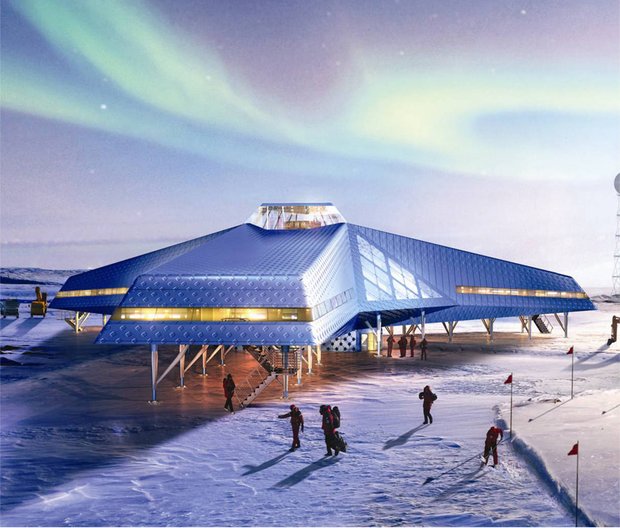
Architect Impression, Jang Bogo, Space Group and KOPRI
30 September 2014
by Harriet Seabourne
We are pleased to announce that Ice Lab: New Architecture and Science in Antarctica has made its international debut in Christchurch and will open at the Otago Museum in Dunedin on December 6th. Ice Lab will run as part of NZ IceFest, an annual festival in New Zealand which celebrates and highlights the importance of Antarctica and the Southern Ocean to the world.
Commissioned by the British Council and curated by The Arts Catalyst, the exhibition features five imaginative designs for Antarctic research stations from the newly opened British Antarctic Survey’s Halley VI Research station to the speculative Iceberg Living Station. Ice Lab was designed by We Made That with graphic design by OK-RM and gives visitors a unique view of the inspiration, ingenuity and creativity behind architecture in the coldest, windiest, driest and most isolated place on earth.
The exhibition, furthermore, documents the scientific research which takes place within and around the polar stations, such as collecting 4.5 billion year old meteorites which show how the solar system was formed, drilling ice cores whose bubbles of ancient air tell of Earth's climate history, and studying the Antarctic's Mars-like Dry Valleys.
Included in the exhibition are two artworks by Torsten Lauschmann. Whistlers and Ice Diamond envelope audiences in a bewitching immersive environment, playfully offering visitors sounds, sights and sensations evoking the disorientating Antarctic landscape.
The featured projects are:
British Antarctic Survey’s Halley VI The first fully relocatable polar research station in the world became fully operational in February 2013 and signals a new dawn for 21st Century polar research. Opening 100 years after Captain Scott’s famed Antarctic expeditions, this new state of the art facility, designed by Hugh Broughton Architects and engineered by AECOM (UK) fulfils the UK’s ambition to remain at the forefront of scientific endeavour. Located 10,000 miles from the UK on a floating ice shelf, the new station is designed to be self-sufficient, able to withstand freezing winter temperatures of minus 55ºC, have minimal impact on Antarctica’s pristine environment, and be an aesthetically stimulating place to live and work.
Princess Elisabeth Antarctica Conceived, designed, constructed and operated by the International Polar Foundation (Belgium), Princess Elisabeth is Antarctica's first zero-emission station. Perched on a nunatuk, 200km from the coast, at an altitude of 1400m, the aerodynamic stainless steel structure can withstand strong Antarctic wind, and is layered so that no form of interior heating is needed. The station seamlessly integrates renewable wind and solar energy, water treatment facilities, passive building technologies and a smart grid for maximising energy efficiency.
Bharati Research Station India’s third Antarctic research station by bof Architekten / IMS (Germany) is a striking modernist structure made from 134 prefabricated shipping containers. Wrapped in a special aluminium case its extensive glazing offers magnificent panoramic views whilst withstanding powerful winds, below 40 degree Celsius temperatures, blizzards and unfathomable loads.
Jang Bogo Korea is becoming a significant player in Antarctic research and Jang Bogo, by Space Group (South Korea), became one of the largest year-round bases on the continent when it opened earlier in 2014. The station’s aerodynamic triple-arm design provides resistance to the elements and accommodate up to 60 personnel during the busy summer season.
Iceberg Living Station A speculative design by David A. Garcia / MAP Architects (Denmark) for a future research station made entirely from ice, Iceberg Living Station negates the need to transport foreign materials to Antarctica. The station will be holed out of a large iceberg, using caterpillar excavators that are traditionally used to clear snow. It will eventually melt, resolving the issue of removing it at the end of its life course.
Ice Lab: New Architecture and Science in Antarctica will run at Canterbury Museum until 23 November 2014, it will then tour to Dunedin where it will show at Otago Museum from December 6 – 1 March 2015. Ice Lab’s cross-disciplinary, international focus is captured in an accompanying publication – which can be downloaded as an e-book